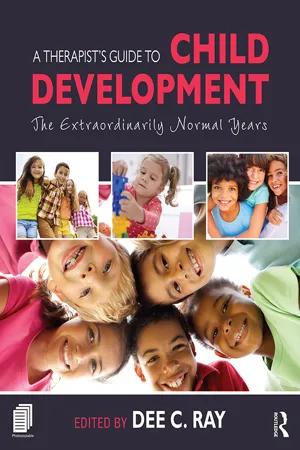An Overview of Child Development
In the world of mental health, most therapists would agree that each child is extraordinary; each child is unique; each child follows an individual path of meaning-making and interaction. Each child deserves to be regarded as an individual with his or her own ways of thinking and his or her own ways of being. Just as does any adult, a child will create and construct a personal reality from relationships, interactions, and events in his or her life. The child will then operate on the basis of this phenomenological perception. These views of children are primary to therapeutic work. In order to facilitate expression, growth, and change, a therapist must see the world through the individual child's eyes.
Yet the phenomenological world sits in the context of the real world. In this real world, children follow fairly typical stages of development. For more than 100 years, researchers have followed the maturational paths of children and concluded that they follow a predictable trajectory of cognitive, physical, and emotional development (NAEYC, 2009). Although there is no way to predict how each child will construct his or her personal reality, there is strong agreement that children will progress sequentially through developmental stages – and often at predictable time periods. If therapists seek to understand each child's world, they will benefit from understanding the world of children; in so doing, the therapist experiences the child as a unique individual traversing through expected chronological and naturally occurring changes. Each child is extraordinarily normal.
The Problem with “Normal”
My son can't sit still. He's always moving. Is that normal?
My daughter seems scared of everything. Is that normal?
“Is that normal?” I believe that this may be the question we are asked most frequently as therapists. Parents want to know that their children are progressing at a good pace, that they have a sense of belonging, and that they will ultimately be successful in adulthood. “Is that normal?” is the question used to evaluate a child's movement toward these goals. The therapist's answer to this question affects the parental view of the child: what the parent expects from the child and how the parent will respond to the child. “Is that normal?” is loaded with multiple meanings for parents, including “Will she be okay?,” “Should I be worried?,” “How will he fit in with others?,” and “What should I be doing to ensure that she'll be normal?”
As therapists who are knowledgeable regarding the limitations of the word “normal,” we will often shy away from answering this question. We would like to help the parent to see that each child is unique and worthy. Each child is growing at his or her own pace, on his or her own individualized path. We want parents to embrace their children as persons who do not strive to be normal, but strive to be fulfilled, contributory, and in relationships with others. As we continue to enlighten parents regarding the distinctive value of not being normal, we can also use research and a century of child development observations to help parents to understand the continuum of typical behavior for children at different ages. Therapists can guide parents to develop further understanding of their children in the context of chronological and developmental age. We can help parents to set reasonable expectations for their children and to avoid the pitfalls of rushing a child through childhood.
As therapists, we are also faced with the trials of the word “normal.” Not only does Western culture emphasize the importance of being normal, but also the field of mental health goes to great lengths to identify and categorize what is “abnormal” or what qualifies as a disorder (APA, 2013). Therapists are charged as arbiters of normal, providing criteria, reports, and labels with which to distinguish the normal from the abnormal. If a therapist embraces this role within mental health, it is incumbent on the therapist to know and understand thoroughly what is normal among everyday children. Therapists’ knowledge of normal is sometimes limited because they are encircled by children who are struggling. Therapists often make the mistake of labeling a child “abnormal” when the child responds to an abnormal event in a very developmentally appropriate way. In these cases, it is the event that is abnormal, not the child or the child's reaction. A therapist's knowledge of typically expected developmental stages safeguards children against being inappropriately labeled. Even the most normal of children, by virtue of being human, will encounter obstacles, challenges, and emotional struggles throughout childhood. The therapist's knowledge of development informs his or her choice and execution of intervention. And this knowledge is best gathered through literature on child development. Understanding the cognitive, physical, and emotional lives of children at various ages provides a roadmap for therapists to select appropriate and effective mental health interventions.
The Basic Principles of Development
Children develop best in an environment of physical and emotional safety
It is commonly known that infants will suffer cognitively and physically if not given food, shelter, and at least minimal relational nurturing. Brain activity will be negatively affected and physical growth can often be inhibited by a lack of proper environment. Although this is widely accepted knowledge regarding infants, there is less awareness of the need for safety in young and middle childhood. Physical and emotional abuse or neglect slows the developmental process by focusing children on attaining what is needed for survival. If food is limited or physical safety is threatened, many children will rigidly hold to their current understanding of the world and will often fail to expand their ways of thinking or to take in new information. When children are emotionally unsafe when expressing new cognitive abilities, they will limit their expression and use of such abilities. If caretakers respond in harmful or negative ways to a child's initiative, that child's repeated experiences of failure will discourage his or her further attempts. However, when children are physically nurtured and emotionally safe, new information or experiences are seen as opportunities for interaction or exploration and will spur further growth.
Higher is not better
Although most developmental theories are presented as stage theories in which humans progress from one stage to the next, developmentalists stress the importance of not valuing later stages more than earlier stages. Each stage of development serves a purpose or concentrates on a necessary task – a purpose or task that is essential to meaning-making and self-construction. No one stage is better than another; they are all integral to development. A young child who appears opportunistic and reward-driven is becoming initiated into a world of rules within which there are consequences for actions. This is an essential experience, leading to an understanding of how the world works and, from that understanding, to finding a sense of self in that world.
Development cannot be rushed, but it can be slowed
Development is not a race. In current Western culture, we often applaud children who appear to display advanced development and advocate intervention for those who do not move as quickly (Ray, 2011). Children move at their own pace, when they are developmentally ready to do so. Although we know through observational research that we can estimate the ages at which children might reach certain stages, these estimates are crude and may not fit the experience of many children. Stage sequences are fairly predictable, but pace is not. If a child is not progressing at the rate of his or her peers, a therapist may look for barriers or, possibly, simply differences in personality. Children will meet interventions designed to force development with anxiety, self-doubt, and often overt resistance. Different developmental paths do not equal pathology. Burman (2008, p. 22) wrote: “The normal child, the ideal type, distilled from the comparative scores of age-graded populations, is therefore a fiction or myth. No individual or real child lies at its basis”. Hence there is no one normal way in which to develop; rather, there is a long continuum, and most children fit at some point on the continuum, moving along it at an individualized pace.
Although development cannot be rushed, it can be slowed. As mentioned in relation to the need for physical and emotional safety, a child's development will be limited if he or she experiences certain events or environments. Trauma events are likely to slow development, to initiate regressed development, or in some cases to interrupt development altogether. Slower and regressed development is a developmentally appropriate response to trauma. It is typically the way in which children respond to trauma and it allows for recovery from, and integration of, new experiences. More problematic, however, is a child's withdrawal from interaction or exploration: This response is likely to result in the interruption of development entirely, limiting the child's ability to garner necessary support to work through the trauma experience. Loss – especially repeated loss – is also likely to slow development, because a child is spending internal resources on maintaining homeostasis and thus has little energy for growth experiences.
Development is not defined by skills
Natural development tends to be holistic, in that a child's mind and body move forward at relatively the same speed. As a child's body and physical ability grow, cognitive understanding becomes more abstract and emotional life becomes more complex. However, if a child is required and/or expected to accomplish tasks in a certain domain, it is possible that he or she will be able to develop the requisite skills. In current Western culture, children are exposed to developmentally inappropriate tasks before they are ready, such as academic or social tasks. For example, a 4-year-old may be required to write with an adult-like pencil grip or may ...

